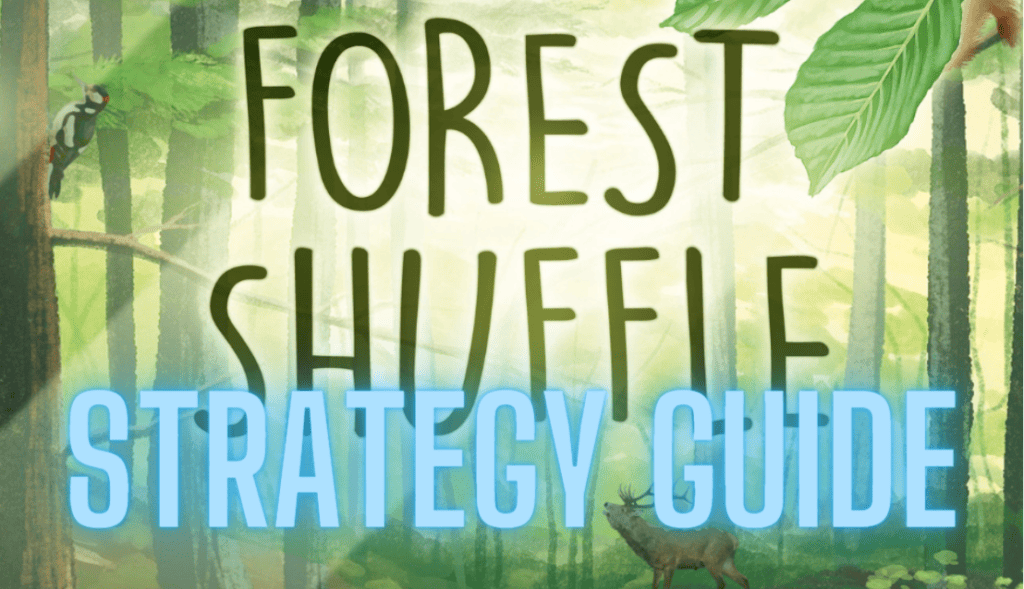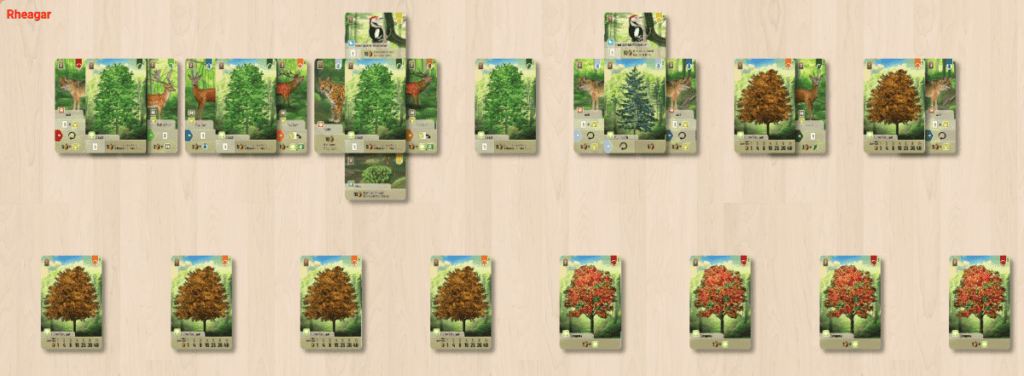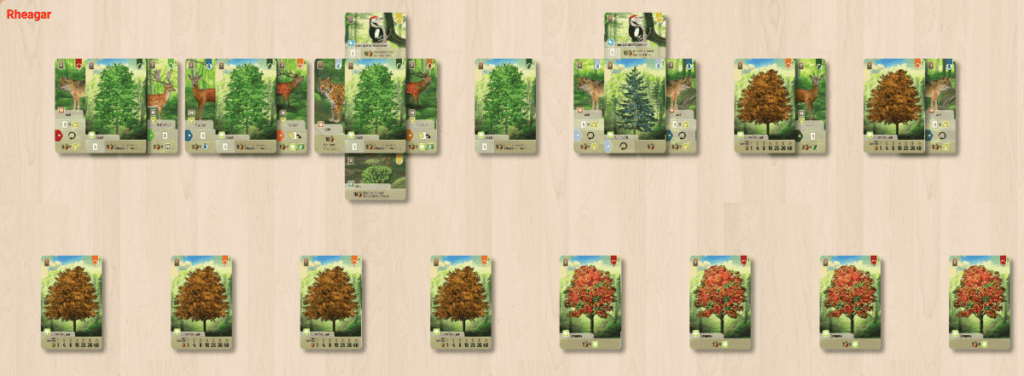
Forest Shuffle is a relatively new game that combines an entertaining mixture of strategy, skill, and luck. I discovered this game online and quickly became hooked by its replayability and opportunities for strategic play. I noticed that there aren’t a lot of resources available to learn strategy from, so I spent a lot of time learning and formulating my own strategies that have helped me improve dramatically. These Forest Shuffle strategies will help you to improve your game and win more often.
In general, the best Forest Shuffle strategy is to create a thematic forest where all cards are working in conjunction with one another. Choose a theme early in the game and stick to it while denying important cards to your opponent(s). Exponential growth is more powerful in 2-player games.
Every game of Forest Shuffle plays out differently, so it’s important to be flexible and understand each of the strategies I outline below. I’ll go into the ‘how’ and ‘why’ so that you can implement these strategies in your own games and come out on top more often.
Know which cards work well together
Winning a game of Forest Shuffle is all about creating a synergistic, harmonious forest where everything works together to score you more points. To win, you first need to be familiar with all of the cards and how they work together. There are several groups of cards that work very well together to generate exponentially more points as they are played together. I like to call these groups of cards ‘Themes‘. Good Forest Shuffle players usually focus almost entirely on one or two of these themes as part of their overall strategy.
Large Forest Theme
These cards work together to score lots of points based on the number of trees in your forest. In general, you will score exponentially more points with these cards if you have more trees. Some of the most powerful cards in the Large Forest Theme are the Sycamore, Great Spotted Woodpecker, Chanterelle, and Moss.
Like most other themes, the Large Forest Theme is best used in conjunction with others. I like to combine it with the Amphibian and/or Paw Animal themes (described below).
Cards that are often used in the Large Forest Theme are:
| Card | Text |
|---|---|
| Sycamore | 1 point for every tree |
| Wild Strawberries | 10 points if you have all 8 tree species |
| Beech | 5 points if you have 4+ Beeches |
| Great Spotted Woodpecker | 10 points no other forest has more trees |
| Chanterelle | Draw a card whenever you play a tree |
| Moss | 10 points if there are at least 10 trees in your forest |
| Roe Deer | 3 points per Beech |
| Red Deer | 1 point per tree and plant |
| Violet Carpenter Bee | 0 points, counts as 1 additional tree of its tree type |
| Oak | 10 points if you have all 8 tree species |
Bat Theme
The Bat Theme doesn’t scale exponentially like some of the others in this list, but it can be an effective supplement. In order to make this theme effective you must play at least 3 different bat species and combine them with Gnat, European Fat Dormouse, and Penny Bun cards.
Cards used in the Bat Theme are:
| Card | Text |
|---|---|
| Barbastelle Bat | 5 points if you have 3+ bat species |
| Bechstein’s Bat | 5 points if you have 3+ bat species |
| Brown Long-Eard Bat | 5 points if you have 3+ bat species |
| Greater Horseshoe Bat | 5 points if you have a least 3+ bat species |
| Penny Bun | Draw a card when you play a card atop a tree |
| Gnat | 1 point per bat, play any number of bat cards as an effect |
| European Fat Dormouse | 15 points if a bat also occupies its tree |
Bird Theme
I rarely see birds used as a focus in high-level play but, like the bats, the Bird Theme can be a nice way to bring in some supplemental points. The most important card in the Bird Theme is the Goshawk, which provides 3 points for every bird in your forest. The cards involved in this theme also tend to help you draw more cards, giving you more flexibility.
Cards used in the Bird Theme are:
| Card | Text |
|---|---|
| Goshawk | 3 points for every bird |
| Chaffinch | 5 points if on a Beech |
| Tawny Owl | 5 points, draw 2 cards as bonus |
| Eurasian Jay | 3 points, take another turn |
| Penny Bun | Draw a card when you play a card atop a tree |
Deer & Wolf (Paw Animal) Theme

This is one of my favorite themes in Forest Shuffle because there are so many opportunities for exponential growth. The most important card is the Wolf, which will give you 5 points for every deer in your forest. If you can find and play more than one Wolf it becomes that much more powerful. Other opportunities for exponential growth include the Fallow Deer which scores 3 points per cloved animal and the Red Deer which scores 1 point per tree or plant.
Cards used in the Deer & Wolf Theme are:
| Card | Text |
|---|---|
| Wolf | 5 points per deer in your forest, draw as many card as you have deer |
| Fly Agaric | Draw a card when you play a paw card |
| Roe Deer | 3 points per Beech |
| Red Deer | 1 point per tree and plant |
| Lynx | 10 points if at least 1 Roe Deer |
| Fallow Deer | 3 points per cloved animal |
Hare (Paw Animal) Strategy
This theme is very closely related to the Deer & Wolf Theme because they both involve paw animals, so some of the mechanics work very well together. However, you can use each of them well enough on their own to make them worthwhile, so I’ve split them up here. The most important card in the Hare Theme is the Red Fox, which grants 2 points for every European Hare.
Cards used in the Hare Theme are:
| Card | Text |
|---|---|
| European Hare | 1 point per European Hare |
| Red Fox | 2 points per European Hare, Draw 1 card per Euro Hare |
| Stag Beetle | 1 point per pawed animal |
| Fly Agaric | Draw a card when you play a paw card |
| Squeaker | 1 point |
| Wild Boar | 10 points if you have at least 1 squeaker |
Amphibian Strategy
The Amphibian Theme is another one of my favorites because of the opportunities for exponential growth, and it scores more points for having lots of amphibians and related cards in your forest. The most important card in the Amphibian Theme is the Tree Fern which scores 6 points for every amphibian in your forest. Other opportunities for exponential growth are the Tree Frog which scores 5 points per Gnat and the Wood Ant which gets 2 points per card below a tree.
Cards used in the Amphibian Theme are:
| Card | Text |
|---|---|
| Tree Ferns | 6 points for every amphibian |
| Common Toad | 5 points if 2 Common Toads share a slot |
| Parasol Mushroom | Draw a card when you play a card below a tree |
| Tree Frog | 5 points per gnat |
| Fire Salamander | Exponentially more points for every Salamander |
| Wood Ant | 2 points per card below a tree |
| Pond Turtle | 5 points, draw a card when played |
| Gnat | 1 point per bat, play any number of bat cards as an effect |
Butterfly Strategy
The Butterfly Theme is very effective because it combines the potential for exponential growth with low- or no-cost cards. The most important cards in the Butterfly Theme are the Hedgehog which gives 2 points for every Butterfly and the Bullfinch which scores 2 points for every insect. The Mole is also particularly useful because it allows you to play many butterflies at once with no cost.
Cards used in the Butterfly Theme are:
| Card | Text |
|---|---|
| Large Tortoiseshell | Exponentially more points for more butterfly species |
| Camberwell Beauty | Exponentially more points for more butterfly species |
| Purple Emperor | Exponentially more points for more butterfly species |
| Silver-Washed Fritillary | Exponentially more points for more butterfly species |
| Peacock Butterfly | Exponentially more points for more butterfly species |
| Penny Bun | Draw a card when you play a card atop a tree |
| Hedgehog | 2 points for every butterfly |
| Bullfinch | 2 points for every insect |
| Mole | Play any number of cards by paying their cost |
Draw cards early to formulate a plan
At the beginning of the game, it’s essential to develop an effective plan as soon as possible. You should go into every game with a flexible attitude and be prepared to choose a path based on the cards you’re dealt. But before you commit to a plan, it’s best to draw as many cards as you can so that you have as much information as possible.
I like to start almost every game by drawing cards and adding them to my hand. This allows me to see what I have to work with and find cards that work well together and then choose the best path forward.
Another benefit of drawing cards is that it gives you additional opportunities to draw rare and powerful cards like the Wolf or Tree Fern. Obtaining these cards early in the game can give you clear direction so that you don’t waste any turns.
Don’t deviate from your chosen path
Once you commit to a strategy in Forest Shuffle you should always stick to it. Changing strategies mid-game will almost always lead to a loss because it means the cards in your forest will be working towards separate goals.
CHECK IT OUT: If you like Forest Shuffle and you haven’t tried out Wingspan yet, you’re missing out! Wingspan (link to Amazon) is one of the most popular games in the world and has a similar theme to Forest Shuffle.
Usually, you’ll want to focus on just one or two of the strategies/card groups I listed above. Some of them synergize more effectively than others, but you can make almost any combination work. Choose a second strategy to complement the first one you’ve chosen if it makes sense, but never abandon your first strategy once you’ve committed to it.
Create synergy in your forest to maximize value

Every card you play should have a purpose, and it should contribute towards your larger plan. You only get so many turns in a game of Forest Shuffle, so you have to maximize the value you get from each card you play. Never play a card ‘just because’ or because you aren’t sure of what to do. Have a plan in mind and build towards it on every turn.
The best and highest-scoring forests in Forest Shuffle are almost always built around one or two of the themes described above. Any card that doesn’t contribute in some way to your chosen theme(s) is a wasted opportunity.
Pay with cards that aren’t part of your strategy
Since you’re committing to playing cards in just one or two themes, you’ll invariably end up with quite a few cards that don’t contribute to your plan. These cards should be used to pay for the cards you do want to play. This clears out space for more potentially useful cards in your hand and ensures that you aren’t using some useful cards to pay for others.
The only caveat here is if you are holding a card that would clearly be very beneficial to your opponent. For example, if your opponent has played a lot of Deer you don’t want to give him or her the opportunity to draw it from the Clearing. That would give your opponent a huge boost that you likely could have avoided.
Deny important cards to other players
In that same vein, you should be keeping an eye on the type of forest your opponent is creating. Chances are, they’re using one or more of the themes I described above so you should be able to tell pretty quickly what cards would be most important to them.
You can deny these important cards to your opponent in a few ways:
- Draw them yourself from the clearing
- Play them yourself from your hand
- Pay with them when the Clearing will be cleared
- Put them in your Cave
This is especially important in 2 player games. Every point that you manage to deny your opponent is as good as a point you score for yourself.
Focus on exponential growth in 2 player games
Speaking of 2-player games, your strategy should change a bit when you have just one opponent. Since there are fewer players, you’ll get more opportunities to play and have access to more cards. This means that the game goes on longer and allows you to build a larger forest.
Being able to play more cards means that exponential growth will be even more powerful. You’ll be able to play more cards that feed off of one another, eventually scoring tons of points on every turn.
In a game with more players, you might not get enough cards to reap the benefits of exponential growth. You should consider focusing on more linear or batched scoring opportunities instead of hoping to draw all of the right cards to experience exponential growth.
Churn cards to bring Winter when you’re winning
If you’re up by a significant margin in Forest Shuffle then it’s in your best interest to end the game as soon as possible and secure the win. Prolonging the game just gives your opponents more time to generate more points and catch up to you, so you need to stop them in their tracks.
After the first Winter card is drawn you should start taking this more and more into consideration. If you’re on the fence about playing or drawing cards, it’s usually best to draw more cards to hasten the coming Winter. This is even more important after two Winter cards have been drawn because every card drawn from the pile has the potential to win you the game immediately.
Use your Cave at opportune moments

When I first started playing Forest Shuffle I wasn’t sure how to best use my Cave, but I quickly found that it can be a very useful strategic resource. The two cards that give you access to your Cave are:
- Brown Bear – Place all cards from the Clearing into your Cave
- Raccoon – Place any number of cards from your hand into your Cave and replace them from the Deck
Each of these cards is powerful in its own way. The Brown Bear gives you the opportunity to remove cards from the Clearing that might be useful to your opponent(s) while scoring some points in the process. The Raccoon lets you get rid of otherwise useless cards from your hand and gives you a fresh start. It also provides a way to get rid of cards you don’t want your opponent to have but you don’t want to play yourself.
Thanks for reading! If I missed something or you have your own opinions, please drop a comment below.
What is thr benefit of along out first in hand? Seems to me like you would never want to assume…
Your strategy comments are excellent, well thought out and very helpful! Thank you
You would only get to draw and play a Sanctuary card on turn two of round one if the Region…
Rule question. If in phase one of round one I play a Region card with a Clue symbol at the…

Leave a Reply